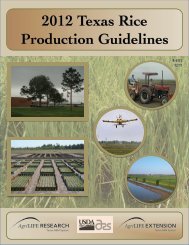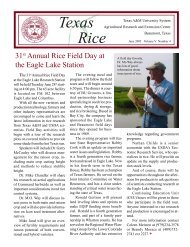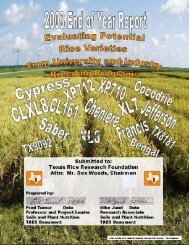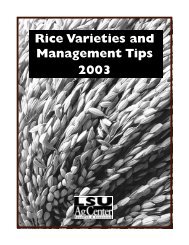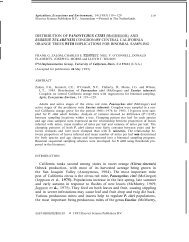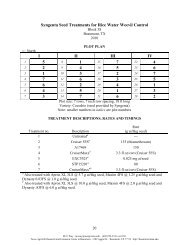2007 - Texas A&M AgriLIFE Research Center at Beaumont - Texas ...
2007 - Texas A&M AgriLIFE Research Center at Beaumont - Texas ...
2007 - Texas A&M AgriLIFE Research Center at Beaumont - Texas ...
You also want an ePaper? Increase the reach of your titles
YUMPU automatically turns print PDFs into web optimized ePapers that Google loves.
Shallow flood depth decreases the amount of w<strong>at</strong>er<br />
required and increases yield if grass and weeds are controlled.<br />
Land leveling, or grading, makes it possible to<br />
maintain uniform, shallow flood depth; improve uniformity<br />
of w<strong>at</strong>er distribution when the field is flushed; and improve<br />
surface drainage.<br />
Temporary shallow flooding<br />
An adequ<strong>at</strong>e w<strong>at</strong>er supply and timely flushing (temporary<br />
shallow flooding) are essential for maximum yields.<br />
Early season w<strong>at</strong>er management is important, but often<br />
overlooked. The planting method largely determines appropri<strong>at</strong>e<br />
early season w<strong>at</strong>er management practices.<br />
Flushing encourages uniform, rapid emergence with<br />
the broadcast, dry seeded method of planting. Flushing is<br />
normally not used to obtain emergence when rice is drilled<br />
into coarse textured soils because these soils are prone to<br />
crusting, thus impeding seedling emergence.<br />
Flushing may be necessary if there is not enough<br />
moisture available for germin<strong>at</strong>ion and/or if emergence is<br />
hindered by soil crusting following a rain. Do not allow<br />
the soil to dry or a soil crust to form on shallow planted,<br />
semidwarf varieties.<br />
<strong>Research</strong> indic<strong>at</strong>es th<strong>at</strong> much of the irrig<strong>at</strong>ion w<strong>at</strong>er<br />
applied in flushing leaves the field as runoff. Improved<br />
management in the flushing oper<strong>at</strong>ion could reduce the<br />
amount of w<strong>at</strong>er required and reduce irrig<strong>at</strong>ion pumping<br />
costs. Introducing exactly the right amount of w<strong>at</strong>er to<br />
accomplish the desired flushing with little or no runoff from<br />
the bottom of the field is difficult with single inlet irrig<strong>at</strong>ion<br />
systems.<br />
A multiple inlet system, which introduces irrig<strong>at</strong>ion<br />
w<strong>at</strong>er to each individual cut, makes efficient flushing much<br />
easier to accomplish and also makes it possible to maintain<br />
freeboard on each levee for storage of rainfall. An inflow<br />
meter also allows you to precisely control the amount of<br />
inflow.<br />
W<strong>at</strong>er seeded rice on heavy soils<br />
When rice is w<strong>at</strong>er seeded on heavy soils, establish a<br />
2- to 4-inch flood as soon as possible after land prepar<strong>at</strong>ion.<br />
The rice should be planted immedi<strong>at</strong>ely to minimize seed<br />
midge damage and ensure a good stand. When seed has<br />
sprouted, drain the w<strong>at</strong>er to a low level or drain it completely<br />
to enable rice seedlings to become well anchored.<br />
If cuts (the areas between levees) are completely drained,<br />
flushing will eventually be necessary to prevent soils from<br />
drying out and reducing seedling stand. Floods th<strong>at</strong> last longer<br />
than 7 to 10 days may lead to seed midge damage.<br />
Early season w<strong>at</strong>er management<br />
Early season w<strong>at</strong>er management should provide soil<br />
moisture for growth of the rice seedlings, discourage germin<strong>at</strong>ion<br />
of weed seeds and maintain high nitrogen fertilizer<br />
efficiency. Young rice plants grow well under altern<strong>at</strong>ing<br />
moist and dry soil conditions, but denitrific<strong>at</strong>ion can seriously<br />
reduce the soil’s nitrogen level under these conditions.<br />
If possible, keep the soil moist to increase nitrogen<br />
efficiency, decrease germin<strong>at</strong>ion of weed seed and reduce<br />
salt damage in areas subject to such damage. Keeping the<br />
soil moist appears to be especially important for semidwarf<br />
varieties.<br />
Delay flushing until 24 hours after propanil is applied<br />
(alone or in combin<strong>at</strong>ion with a preemergence herbicide).<br />
Flushing immedi<strong>at</strong>ely after propanil applic<strong>at</strong>ion washes off<br />
the propanil.<br />
Flood Establishment<br />
Do not put on flood until plants are actively tillering,<br />
assuming continuous flood culture is not being used. To<br />
maintain the flood, apply additional w<strong>at</strong>er to replace th<strong>at</strong><br />
lost by evapor<strong>at</strong>ion, transpir<strong>at</strong>ion, seepage and runoff.<br />
The flood may be drained during mid-season only when<br />
the rice is subject to straighthead. If you need to apply a<br />
mid-season herbicide, lower the flood level to obtain better<br />
exposure of broadleaved weeds. To ensure availability<br />
of w<strong>at</strong>er during the reproductive stage, the rice must be<br />
reflooded <strong>at</strong> least 7 to 10 days before anticip<strong>at</strong>ed panicle<br />
differenti<strong>at</strong>ion.<br />
Maintaining a flood is critical during panicle development.<br />
The rice plant uses w<strong>at</strong>er <strong>at</strong> a high r<strong>at</strong>e during<br />
this period, and moisture stress reduces yield. Maintain a<br />
constant flood to provide adequ<strong>at</strong>e w<strong>at</strong>er for normal plant<br />
growth and development.<br />
Maintain the flood <strong>at</strong> the minimum depth necessary to<br />
control weeds. Shallow flood depth minimizes the quantity<br />
of w<strong>at</strong>er required and increases yield if weeds are controlled.<br />
Field storage of rainfall can also reduce the amount of<br />
irrig<strong>at</strong>ion w<strong>at</strong>er required. However, rainfall can be stored in<br />
the field only if some freeboard is available on each levee<br />
g<strong>at</strong>e.<br />
Fertiliz<strong>at</strong>ion<br />
L. Tarpley and M. F. Jund<br />
<strong>Research</strong> and experience have shown th<strong>at</strong> there is a gre<strong>at</strong><br />
deal of flexibility in how farmers can manage their fertilizer<br />
programs, provided th<strong>at</strong> the basic nutrient requirements are<br />
met. These suggestions provide basic inform<strong>at</strong>ion on which<br />
a farmer can build an economic rice fertilizer program and<br />
make adjustments to fit particular situ<strong>at</strong>ions.<br />
Fertilizer can profoundly influence rice yield, and it is a<br />
major cost for rice production. Therefore, a critical review<br />
of fertilizer practices can mean increased income without<br />
sacrificing yields.<br />
For maximum net profit, apply only those fertilizer<br />
m<strong>at</strong>erials needed for maximum economic yields. If your soil<br />
has been tested accur<strong>at</strong>ely to predict fertilizer needs, you<br />
can have confidence in the fertilizer recommend<strong>at</strong>ions and it<br />
will help you develop an economical fertilizer management<br />
program.<br />
Of the three primary nutrients (nitrogen, phosphorus<br />
–––––––––––––––––––––––––––––––––––––––––––––––––––––––––––––––––––––––––––––––––––– 15



